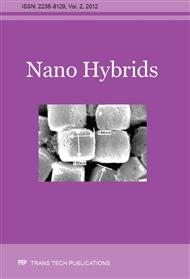[1]
H. Brune, K. Kern in: 1997 Physics and Chemistry of Solid Surfaces vol. 8, ed. D.A. King, D.P. Woodruff (Amsterdam: Elsevier).
Google Scholar
[2]
K. Godling, R. Madden, Structure in the LII, III Absorption of Aluminum and its Oxides. Phys. Rev. 167 (3) (1968) 587-591.
Google Scholar
[3]
M. Kulawik, N. Nilius, H. -P. Rust, H. -J. Freund, Atomic Structure of Antiphase Domain Boundaries of a Thin Al2O3 Film on NiAl(110), Phys. Rev. Lett. 91(25) (2003) 256101.
DOI: 10.1103/physrevlett.91.256101
Google Scholar
[4]
T. Campbell, G. Aral, S. Ogata, R. Kalia, A. Nakano, P. Vashishta, Oxidation of aluminum nanoclusters, Phys. Rev. B: Condens. Matter. 71 (2005) 205413.
DOI: 10.1103/physrevb.71.205413
Google Scholar
[5]
D. Gopireddy, C. Takoudis, Diffusion-reaction modeling of silicon oxide interlayer growth during thermal annealing of high dielectric constant materials on silicon, Phys. Rev. B: Condens. Matter. 77 (2008) 205304.
DOI: 10.1103/physrevb.77.205304
Google Scholar
[6]
C.Y. Ouyang, Ž. Šljivančanin, A. Baldereschi, A First-principles study of γ-Al2O3 (100) surface, Phys. Rev. B: Condens. Matter. 79 (2009) 235410-235417.
Google Scholar
[7]
C. Ruberto, Y. Yourdshahyan, B. Lundqvist, Surface properties of metastable alumina: A comparative study of k- and α-Al2O3, Phys. Rev. B: Condens. Matter. 67 (2003) 195412.
Google Scholar
[8]
S. Mason, C. Iceman, T. Trainor, A. Chaka, Density functional theory study of clean, hydrated, and defective alumina (1102) surfaces, Phys. Rev. B: Condens. Matter. 81 (2010) 125423.
DOI: 10.1103/physrevb.81.169901
Google Scholar
[9]
E. Wallin, J.M. Andersson, E.P. Münger, V. Chirita, U. Helmersson, Ab initio studies of Al, O, and O2 adsorption on α-Al2O3 (0001) surfaces, Phys. Rev. B: Condens. Matter. 74 (2006) 125409-1-9.
Google Scholar
[10]
P. Feibelman, Atomic arrangement and impurity bonding at a к-Al2O3 (001)/Al(771) interface: First-principles calculations, Phys. Rev. B: Condens. Matter. 76 (2007) 235405.
Google Scholar
[11]
J. Henzie, J. Barton, C. Stender, T. Odom, Large-Area Nanoscale Patterning: Chemistry Meets Fabrication, Acc. Chem. Res. 39 (2006) 249-257.
DOI: 10.1021/ar050013n
Google Scholar
[12]
T. Xu, R. Piner, R. Ruoff, An Improved Method To Strip Aluminum from Porous Anodic Alumina Films, Langmuir 19 (2003)1443-1445.
DOI: 10.1021/la0264724
Google Scholar
[13]
B. Fischer, J. Barth, A. Fricke, L. Nedelmann, K. Kern, Growth and surface alloying of Al on Au(111) at room temperature, Surface Science 389 (1997) 366-374.
DOI: 10.1016/s0039-6028(97)00451-2
Google Scholar
[14]
Y. Yu, Z. Tang, Y. Jiang, K. Wu, E. Wang, Thickness dependence of the surface plasmon dispersion in ultrathin aluminum films on silicon, Surface Science 600 (2006) 4966-4971.
DOI: 10.1016/j.susc.2006.08.020
Google Scholar
[15]
J. Pierce, N. Bartelt, R. Stumpf and K. McCarty, Stability of ultrathin alumina layers on NiAl(110), Phys. Rev. B: Condens. Matter. 77 (2008) 195438.
DOI: 10.1103/physrevb.77.195438
Google Scholar
[16]
R. Lazzari, J. Jupille, Wetting and interfacial chemistry of metallic films on the hydroxylated a-Al2O3"0001… surface, Phys. Rev. B: Condens. Matter. 71 (2005) 045409.
Google Scholar
[17]
A. Olivaa, P.O. Quintanaa, J. Ceha, M. Coronaa, Aguilarb 1999 Current induced effects in aluminum thin films, Thin Solid Films 353 (1999) 1-7.
DOI: 10.1016/s0040-6090(99)00370-3
Google Scholar
[18]
G. Binnig, H. Rohrer, Ch. Gerber, E. Weibel, 7x7 Reconstruction on Si(111) Resolved in Real Space, Phys. Rev. Lett. 50(2) (1983) 120-123.
DOI: 10.1103/physrevlett.50.120
Google Scholar
[19]
B.L. Sharma, Metal-Semiconductor Schottky Barrier Junctions and Their Applications, Plenum Pub Corp, New York, (1984).
Google Scholar
[20]
Y. Hirota, 1993 Schottky characteristics of GaAs surface cleaned by ultrasonic running deionized water treatment. Appl. Phys. Lett. 63(14) (1993) 1936-(1938).
DOI: 10.1063/1.110606
Google Scholar
[21]
L. Lajaunie, M. David, J. Barbot, Physical properties of Co/n-Ge Schottky contacts. J. Phys. D: Appl. Phys. 4 (2011) 125103.
DOI: 10.1088/0022-3727/44/12/125103
Google Scholar
[22]
N. Agrait, A. Yeyati, J. van Ruitenbeek, Quantum properties of atomic-sized conductors, Physics Reports, 377 (2003) 81-279.
Google Scholar
[23]
B. Ludoph, J. van Ruitenbeek, Conductance fluctuations as a tool for investigating the quantum modes in atomic-size metallic contacts, Phys. Rev. B: Condens. Matter. 61 (2000) 2273-2285.
DOI: 10.1103/physrevb.61.2273
Google Scholar
[24]
R. Smit, Y. Noat, C. Untiedt, N. Lang, M. van Hemer, J. van Ruitenbeek, Measurement of the conductance of a hydrogen molecule, Nature 419 (2002) 906-909.
DOI: 10.1038/nature01103
Google Scholar
[25]
F. Miller, A. Vandome, J. McBrewster, Kelvin Probe Force Microscope, Berlin: Betascript Publishing, (2010).
Google Scholar


